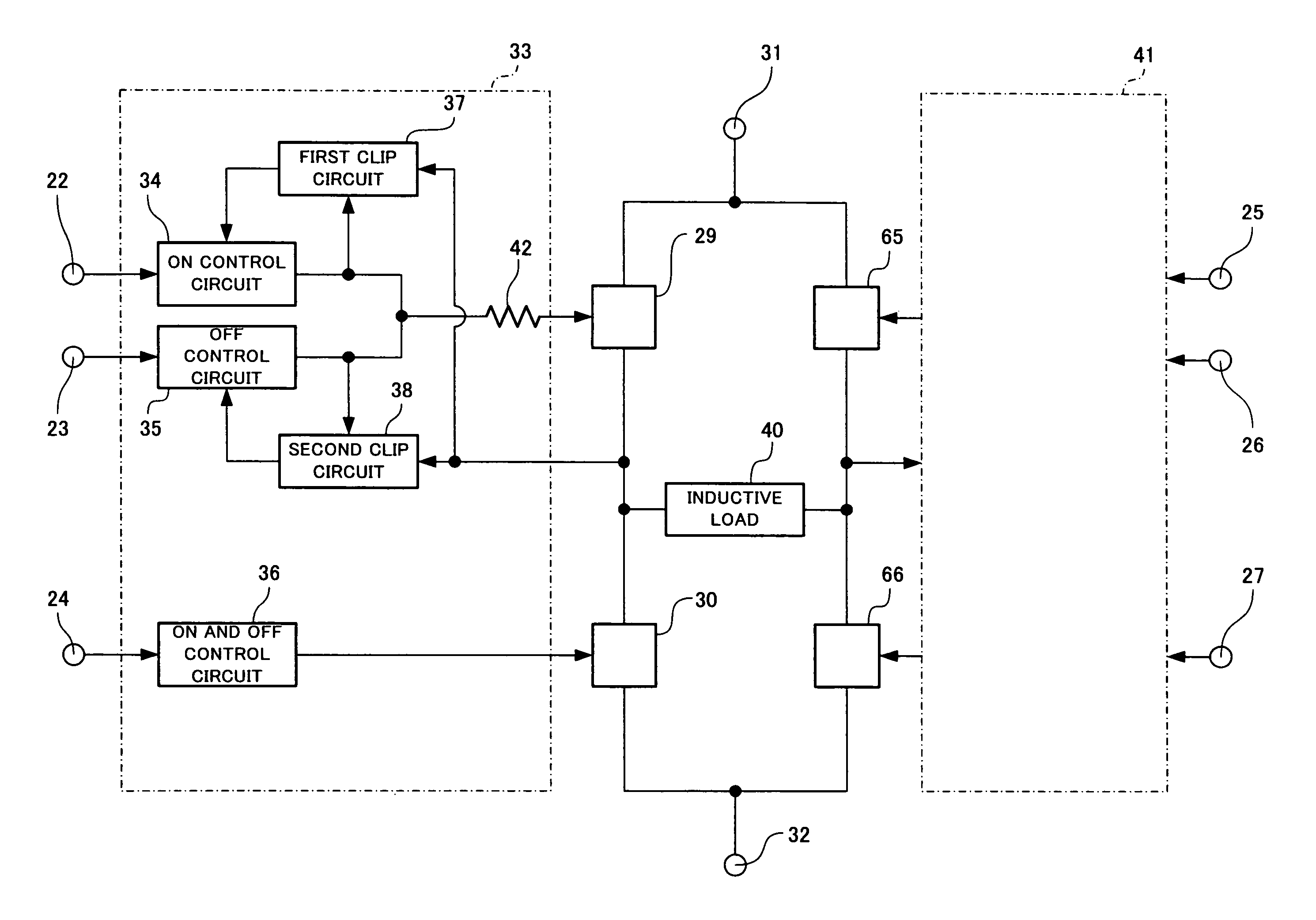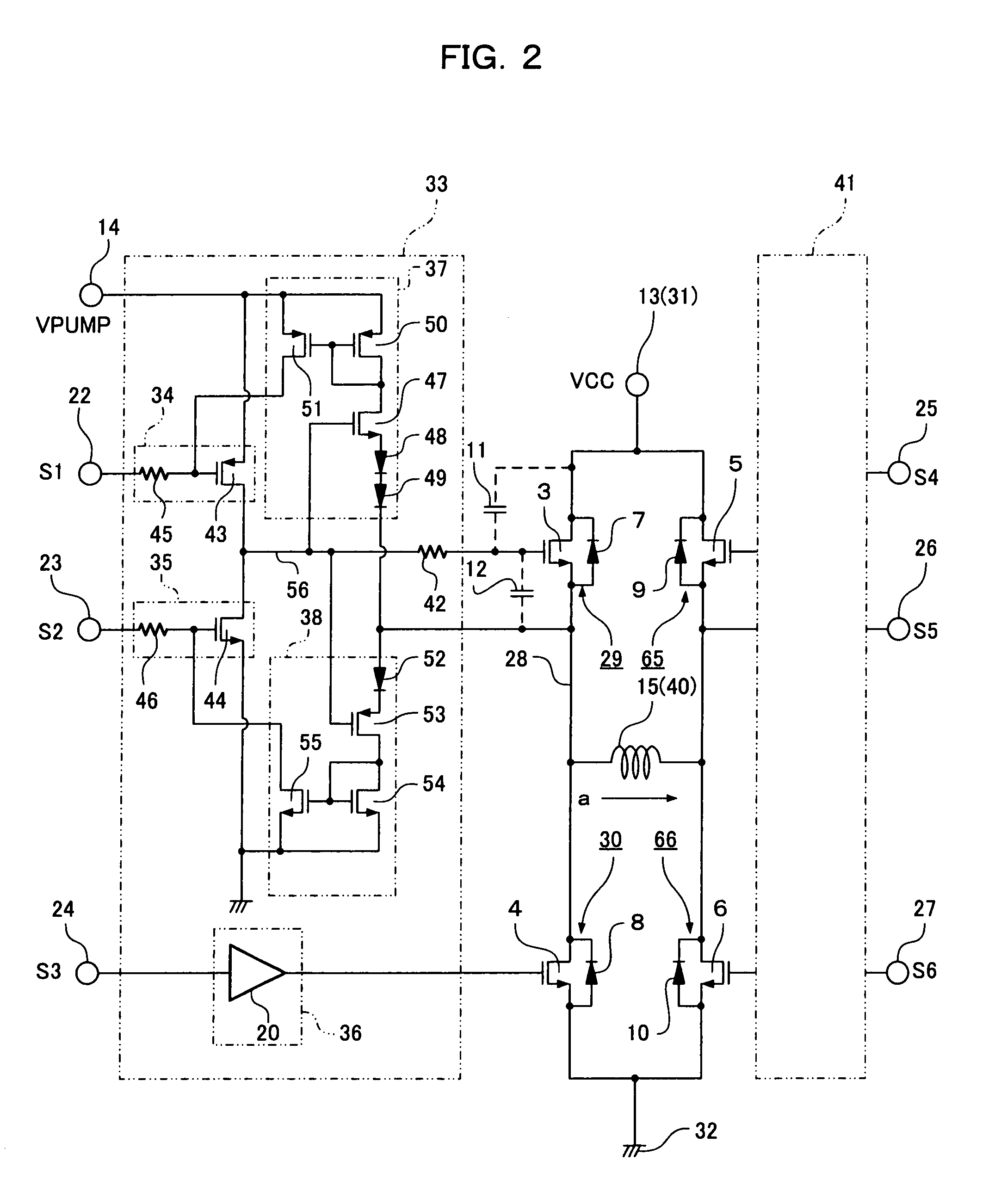Switching control system and motor driving system
a technology of switching control system and motor driving, which is applied in the direction of electronic commutators, pulse techniques, dynamo-electric converter control, etc., can solve the problems of low switching speed, possible destruction or disturbance of other electronic equipment, and malfunctioning or destroying elements, etc., and achieve linear slew rate, linear slew rate, and easy setting
- Summary
- Abstract
- Description
- Claims
- Application Information
AI Technical Summary
Benefits of technology
Problems solved by technology
Method used
Image
Examples
embodiment 1
[0099]FIG. 1 shows a block diagram of Embodiment 1 of the present invention. Reference numerals 29 and 30 denote a first output transistor and a second output transistor. The output transistors 29 and 30 and output transistors 65 and 66 constitute an output circuit. Reference numerals 31 and 32 denote a first power supply terminal and a second power supply terminal, respectively, which are connected to the output circuit. Reference numeral 33 denotes a predrive circuit that drives the output transistors 29 and 30. Reference numeral 41 denotes a predrive circuit that drives the output transistors 65 and 66. Reference numeral 40 denotes an inductive load driven by the output circuit. The output transistors 29 and 30 are N-type MOS transistors. A drain terminal of the first output transistor 29 is connected to the first power supply terminal 31. A source terminal of the first output transistor 29 is connected to a drain terminal of the second output transistor 30. A source terminal of ...
embodiment 2
[0152]FIG. 7 shows a circuit diagram of Embodiment 2 of the present invention. FIG. 7 shows a configuration corresponding to that of Embodiment 1 to which a resistor 57 is added. In the configuration in FIG. 7, the clip voltage setting circuit in the first clip circuit 37 is composed of the diodes 48 and 49 and the resistor 57. The clip voltage setting circuit in the second clip circuit 38 is composed of the diode 52 and the resistor 57. The resistor 57 is connected between the diode 49 and the diode 52 and the node 28. The remaining part of the configuration is the same as that of Embodiment 1, shown in FIG. 2, and will thus not be described below.
[0153]In the configuration according to Embodiment 1, the first clip voltage, determined by the first clip circuit 37, is the fixed plus voltage V1clip. During the clip control, the current I1clip flows from the cathode of the diode 49 toward the node 28. In contrast, in the configuration according to Embodiment 2, shown in FIG. 7, the re...
embodiment 3
[0157]FIG. 8 shows a circuit diagram of Embodiment 3 of the present invention. FIG. 8 shows a configuration corresponding to that of Embodiment 1 to which diodes 59 and 60 and resistors 61 and 62 are added. In the configuration in FIG. 8, the clip voltage setting circuit in the first clip circuit 37 is composed of the diodes 48, 49, and 59 and the resistor 61 and connected to the node 28. The clip voltage setting circuit in the second clip circuit 38 is composed of the diodes 52 and 60 and the resistor 62 and connected to the node 28.
[0158]In Embodiment 3, when a forward breakdown voltage for the diode 59 is defined as V59d and the internal impedance of the diode 59 is sufficiently low compared to that of the resistor 61 and is negligible, the first clip voltage for the node 56 with respect to the voltage of the node 28 can be set equal to {V1clip+V59d+(I1clip*R61)}.
[0159]When a forward breakdown voltage for the diode 60 is defined as V60d and the internal impedance of the diode 60 ...
PUM
 Login to View More
Login to View More Abstract
Description
Claims
Application Information
 Login to View More
Login to View More - R&D
- Intellectual Property
- Life Sciences
- Materials
- Tech Scout
- Unparalleled Data Quality
- Higher Quality Content
- 60% Fewer Hallucinations
Browse by: Latest US Patents, China's latest patents, Technical Efficacy Thesaurus, Application Domain, Technology Topic, Popular Technical Reports.
© 2025 PatSnap. All rights reserved.Legal|Privacy policy|Modern Slavery Act Transparency Statement|Sitemap|About US| Contact US: help@patsnap.com



